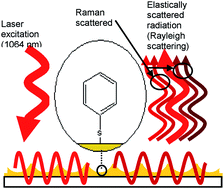Tuning plasmons on nano-structured substrates for NIR-SERS
Abstract
Surface-Enhanced Raman Spectroscopy (SERS) is a very sensitive and selective technique for detecting surface species. Colloidal crystal-templated ‘inverse opal’ nanostructured gold films have been demonstrated to be excellent SERS substrates by various researchers around the globe. However, visible excitation laser sources commonly used in SERS experiments can cause photochemical reactions on the surface as well as fluorescence from the adsorbed molecules. A way to circumvent this possibility is the use of Near Infra-Red (NIR) laser sources. This demands appropriate design of substrates for NIR-SERS in order to obtain maximum enhancement of signals from analytes. In the current paper, we use systematic variation of sphere size and electrochemical control over film height to tune plasmons on such nanovoid substrates. We use plasmon maps as a tool for predicting NIR-SERS enhancements recorded with a 1064 nm laser source for


 Please wait while we load your content...
Please wait while we load your content...